The Facebook algorithm is a hot topic for social media marketers, merchantry owners, journalists, the public, world leaders — basically anyone who uses Facebook to slosh or distribute content.
Whether you love it or hate it, the simple truth is you’ve got to work with it if you want your Facebook marketing efforts to succeed. Here, we explain everything you need to know well-nigh the algorithm Facebook uses to rank content and shape the feeds of its 2.93 billion users.
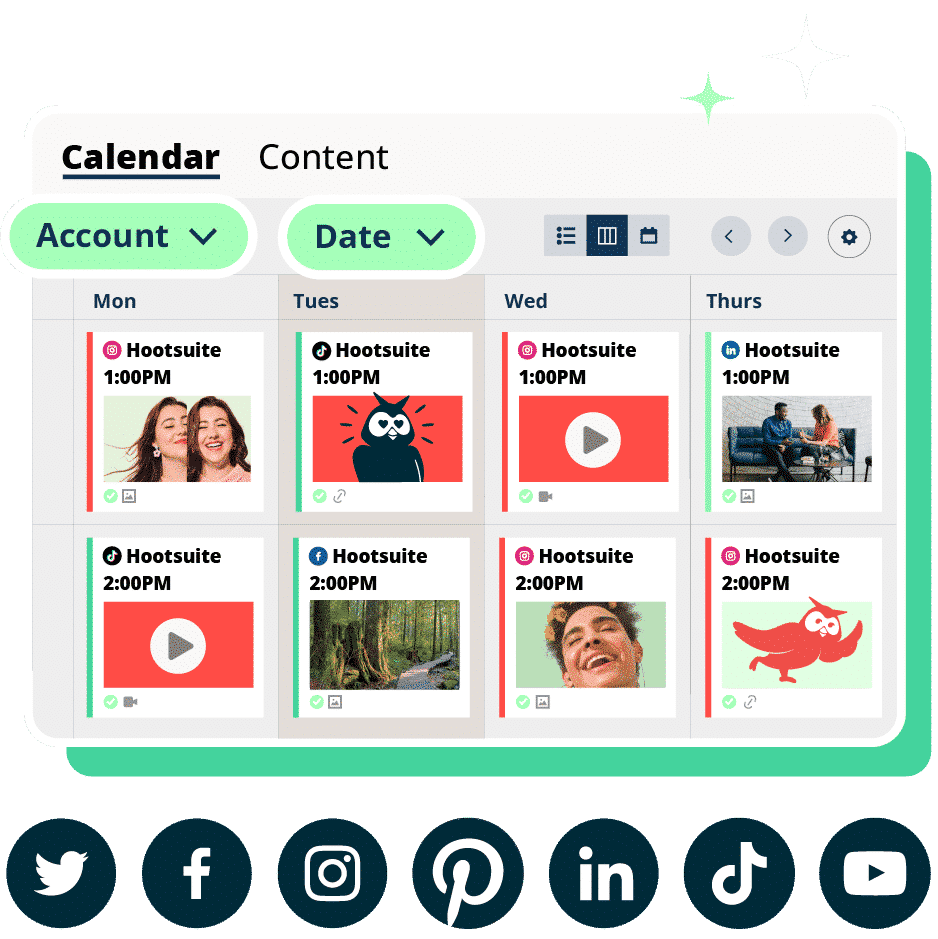
Create. Schedule. Publish. Engage. Measure. Win.
Free 30-Day Trial
What is the Facebook algorithm?
The Facebook algorithm is a set of rules that rank content wideness the platform. It determines what people see every time they trammels Facebook and in what order that content shows up. Facebook calls this “personalized ranking.”
Essentially, the algorithm evaluates every post, ad, Story, and Reel. It scores content and then arranges it in descending order of interest for each individual user. This process happens every time a user refreshes their feed.
According to Facebook, the social network uses algorithms to “arrange all of the content you could see on [the feed, Search, Marketplace, Groups, and Watch] with the aim of showing you the things we think you may be most personally interested in at the top of each surface.”
Facebook algorithm changes for 2024
Now that we understand what the Facebook algorithm is, let’s swoop into how it’s waffly in 2024. As mentioned above, the algorithm is constantly evolving and stuff updated to ensure a largest user experience.
The main thing you need to know is that Artificial intelligence (AI) has wilt an integral part of the Facebook algorithm. With its wide machine learning capabilities, AI helps personalize content for users by analyzing their policies and preferences on the platform.
Here are some of the changes you can expect in 2024:
1. Increasingly focus on meaningful interactions
Facebook has made it well-spoken that it wants to prioritize posts that spark conversations and generate meaningful interactions between users. Posts that don’t receive engagement may see a subtract in reach.
2. Relevance score calculation
The algorithm calculates a relevance score for each post and uses it to rank content in users’ feeds. Factors that influence this score include the type of content, user interactions with similar posts, and how long a user spends viewing posts in the same category.
3. Predicted time spent on a post
AI helps predict how much time a user is likely to spend viewing a post. This prediction is based on signals such as previous interactions with similar posts and the type of content in the post.
4. Likelihood of engagement
The Facebook algorithm moreover predicts how likely a user is to engage with a Page or view spare comments on a post. Factors that influence this prediction include past interactions with Pages, time spent on similar posts, and worriedness on Pages.
5. Balanced mix of content types
The algorithm is designed to show users a variety of post types, such as videos, photos, links, and text posts. This ensures users don’t see multiple posts of the same type in a row.
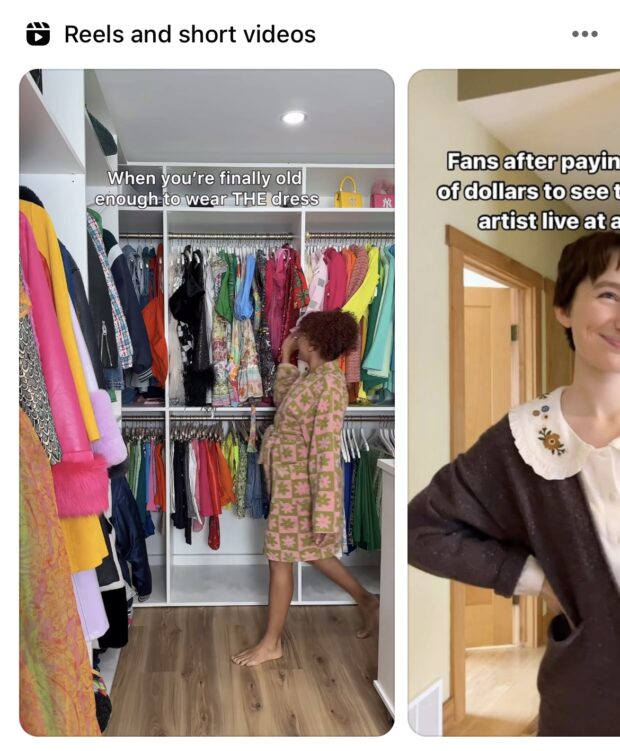
5. Worthiness of a post
Factors like the number of shares, reactions, and the category of the post’s tragedian determine whether a post is deemed “worthwhile” by users. This includes how many reactions have been widow to the post per number of views, how many times the post has been shared, and how many Pages a user has hidden.
6. Transparency and tenancy for users
Facebook is working towards providing increasingly transparency and tenancy for its users. This includes features like the “Show More, Show Less” tool, which allows users to customize their feed and the option to switch to a chronological feed if desired. Users can moreover create a “Favorites” list to ensure they unchangingly see content from their favorite accounts.
Meta has moreover published increasingly information on how Instagram and Facebook algorithms work on Feed, Stories, Reels, and more, in the form of “system cards”. See the full list of 22 system cards for more.
How does the Facebook algorithm work?
Meta has a whole team of people working on strained intelligence and machine learning. Part of their work is to modernize the algorithms that connect Facebook users with the most valuable content for them.
Over the years, algorithm ranking signals have been widow and removed and have had their importance adjusted.
As of 2024, the Facebook algorithm determines which content is most relevant to a particular user based on four main ranking signals:
- Who posted it: You’re increasingly likely to see content from sources you interact with, including friends and businesses.
- Type of content: If you most often interact with video, you’ll see increasingly video. If you engage with photos, you’ll see increasingly photos. You get the idea.
- How likely you are to engage with the post: If the algorithm thinks you’re likely to comment, like, or share a post, then it’s increasingly likely to show it in your feed.
- How interested will other people be in this post: If the Facebook algorithm determines that a post will generate meaningful interactions between users, such as comments, shares, and replies, it will be ranked higher.
2024 Facebook Feed algorithm
Facebook’s news feed algorithm mainly (but not exclusively) features relevant content from people, brands, and Groups you’re once unfluctuating to. Facebook explains that this algorithm uses four steps to determine the order of the content users see in their feed:
- Inventory: All the content misogynist from the people, pages, and groups you’re unfluctuating with, plus relevant ads and recommended content based on your Facebook activity.
- Signals: These are the ranking signals discussed above.
- Predictions: The algorithm crunches the data from the ranking factors to make custom predictions well-nigh which content you’ll value most.
- Relevance: Each piece of content gets a relevance score, with the highest-scoring posts closer to the top of your feed.
Facebook moreover gives users options that help them train the algorithm and customize their feed:
Adding favorites
You can select up to 30 people and pages to add to Favorites. Posts from these finance will towards higher in the feed.
To wangle Favorites:
- Click your profile picture, then click Settings & privacy
- Then, segregate Feed, then Favorites.
- You can use the other options in this section to snooze, unfollow, or reconnect with other Facebook users.
- You can moreover segregate to view just content from your Favorites.
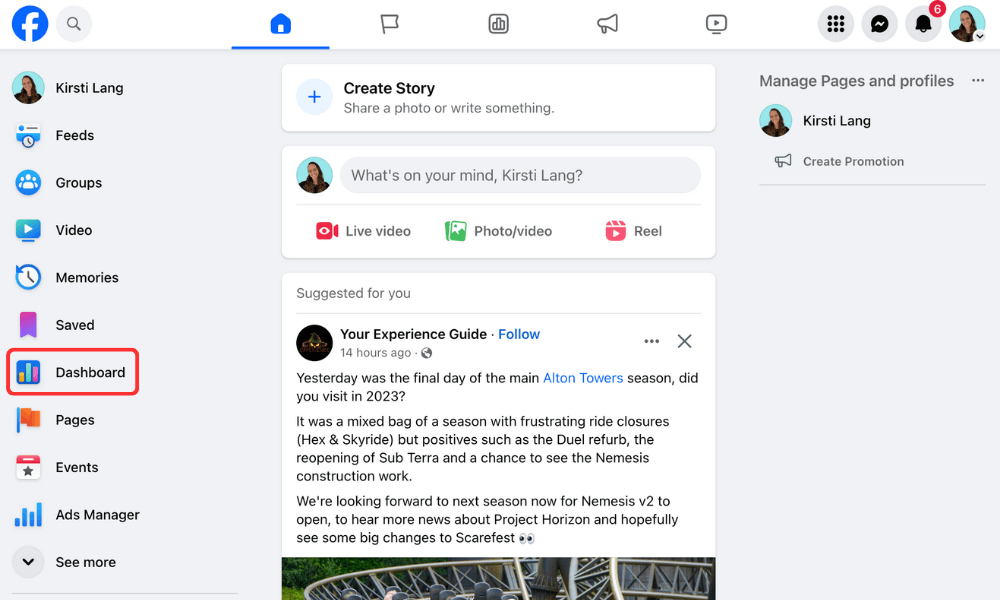
In-feed customizations
Click on any post, and you’ll see a set of options, including hiding the post, snoozing the user, or subtracting or removing the user from favorites.
All of this provides information to the algorithm well-nigh what kind of content you want to see increasingly (or less) of.
On ads, the equivalent option is Hide ad. Facebook will then requite you a set of options to indicate why you want to hibernate the ad. This will help Facebook understand what kind of advertisers you want to hear from, and which you’d rather avoid.
Facebook will remove content that goes versus its Community Standards. They moreover reduce the distribution of “content that people find objectionable,” like “misinformation, a sensationalized health claim, or clickbait.”
Finally, there are some specific words to stave when working with the Facebook algorithms:
- Threatening or violent language
- Harassing language, expressly those that are sexist, homophobic, racist, ableist, and so on
- Words related to harmful stereotypes
- Slurs
- Any other language that violates the Polity Standards
2024 Facebook Reels algorithm
The Facebook Reels algorithm follows the same ranking system as the Feed described above. As described by Meta, those are:
- Inventory
- Signals
- Predictions
- Relevance
These signals can be remoter wrenched lanugo into increasingly unshared deportment and triggers. Here’s how those unravel down:
- Watch time: The percentage of a Reel you’re predicted to watch, as well as how many times the same Reel was viewed by others for less than three seconds.
- Interest: The topics on which you usually engage with, as well as the finance and hashtags you follow. The increasingly a Reel falls into one of these categories, the higher it ranks for you.
- Time spent: How much time people spend viewing Reels when they towards in their feeds. Increasingly time suggests largest quality content that will be ranked higher.
- Intent: How people interact with Reels when they first see them. If someone taps to view a Reel in full screen or clicks on the profile of the author, this signals upper intent, and the algorithm ranks the content accordingly.
- Engagement: Finally, the algorithm ranks how many times the Reel has been viewed by others, how many individuals have clicked on the Reel to view it in full screen, and more.
Beyond these signals, there are some important weightier practices to help make your Reels increasingly discoverable (a.k.a. ranked higher by the algorithm). The overarching principle is to make high-quality content. What exactly does that mean?
Here are the specific recommendations straight from the source:
- Be entertaining and engaging
- Start a trend
- Use seated tools like text, filters, or other effects
- Stick to vertical video
- Add music
- Experiment with variegated approaches
- Use good lighting and camerawork to create a video that’s visually pleasing
And here’s what to avoid:
- Blurry or low-resolution video
- Videos with watermarks from other apps (i.e., TikTok)
- Video with a verge virtually it
- Horizontal video
10 tips for working with the Facebook algorithm
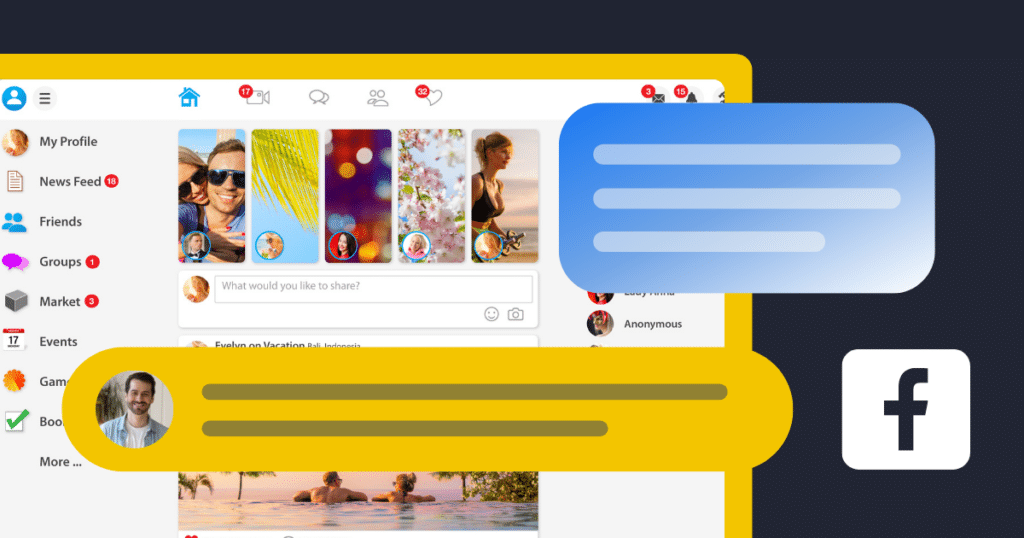
Now that we’ve discussed the specifics of two important Facebook algorithms let’s squint at some tips for navigating them successfully.
1. Understand what your regulars wants to see
Facebook indicates it prioritizes content that is “meaningful, relevant, and informative.” So what does that mean, exactly?
- Meaningful: Content the user will want to talk to friends and family well-nigh or spend time reading (based on past behavior), and videos they want to watch. Overall engagement moreover factors in here.
- Relevant: Content is prioritized by who you engage with most, what type of content you often like, and how many interactions its gathered from other users.
- Informative: Content someone will find “new, interesting, and informative,” which will vary by user.
Understanding what will be meaningful, relevant, and informative to your specific regulars ways you need to understand their unique interests and behaviors. Audience research can help you uncover these traits.
2. Create well-judged and pure content
Facebook says, “People on Facebook value accurate, pure content.” They moreover specify that the types of posts people “consider genuine” will rank higher in the algorithm. Meanwhile, they work to reduce the ranking for posts people find “misleading, sensational, and spammy.”
Here are a couple of tips for signaling the algorithm that your content is accurate and authentic:
- Write well-spoken headlines: Make sure your headline unmistakably describes what users will find in your post. You can certainly get creative with your post captions but don’t use clickbait or misleading titles.
- Be truthful: Put simply, tell the truth. Don’t sensationalize, exaggerate, or outright lie.
On the flip side, here are some things to avoid:
- Content that impedes polity safety, like violence, self-harm, or use of regulated products.
- Content with low-quality health or financial claims, like miracle cures or get-rich-quick schemes.
- Unoriginal content or unattributed news content
- False claims and misinformation
- Facebook algorithm words to avoid, such as racist, homophobic, or violent language
3. Don’t try to manipulate the algorithm
But wait, isn’t this post all well-nigh how to manipulate the algorithm? No, this post is well-nigh understanding how the algorithm works so you can learn what Facebook considers valuable for its users.
It’s up to you to icon out how those overall principles wield to your specific audience. Then, create content that will resonate with them and send positive ranking signals to the algorithm.
Trying to manipulate the algorithm to get increasingly distribution than your content merits is a big no-no. This might include paying for engagement or comments, or engaging in other black-hat strategies (or “inauthentic sharing”) to manipulate reach.
Facebook specifically works to limit the distribution of clickbait, engagement bait, and deceptive landing pages, so trying to manipulate the algorithm with these strategies will only work versus you. Buying likes can moreover reduce your distribution.
As well, new feed preference controls requite users increasingly power to report, block, and hibernate content they finger is irrelevant. Plane if Facebook’s moderators don’t reservation you scamming, your regulars likely will.
The simple message here: Work with the algorithm, not versus it.
4. Engage with your audience
The algorithm Facebook uses prioritizes posts from Pages that a user has had meaningful interactions with in the past. This ways that bumping up your reply game is key.
If a person takes the time to scuttlebutt on your post, don’t waste the opportunity. Making them finger heard with a reply makes it increasingly likely they will protract to scuttlebutt on your posts in the future. This, of course, sends increasingly of those juicy engagement signals to the algorithm. Ignore them and they’ll likely go silent in return.
Pro tip: Whether you’re a solopreneur or you have a whole team of polity managers in place, Hootsuite Inbox makes managing these conversations at scale a lot easier.
5. Get your regulars to engage with each other
Remember how we said the algorithm values content that people want to share and discuss with their friends? Well, a pretty easy way to send that signal is to get people sharing your content and discussing it with their friends.
Facebook itself says that if a post triggers a lot of conversation among a user’s friends, the algorithm applies “action-bumping logic” to show that post to the user again.
To get your regulars sharing and discussing, trammels out our tips for boosting Facebook engagement.
6. Post at the right time
Algorithm’s on Facebook help people see your content plane if they weren’t online when it was first posted. But as we’ve emphasized throughout this post, engagement is a key signal that indicates a post’s potential value. And you’re most likely to get that engagement–especially hair-trigger early engagement–if you post when increasingly of your regulars is online.
Put simply, posting at the right time maximizes the chances that people will see your post, including people who are not online at the time you post!
7. Don’t forget the vital status post
When you’re trying to tumor up your engagement numbers, it can be tempting to seek out complicated Facebook algorithm hacks. But don’t forget the unobtrusive status post. (A post that has no photo, video, or link.)
Research from Hootsuite shows that status posts on stereotype get among the highest engagement rates: 0.11%. Photo posts come in only marginally higher at 0.12%. Videos and link posts come in significantly lower at 0.08% and 0.04%, respectively.
We’re not saying you should create an unshortened Facebook Page of status posts, but they can be an constructive way to communicate simple information and get top engagement scores.
8. Expand your reach via your weightier advocates
Your employees may have increasingly points and authority with the Facebook algorithm than your trademark page does. This is considering they have increasingly points and validity with their own followers and friends.
Your employees can exponentially expand your potential reach when they’re empowered to share your brand’s content to their own circles. Hootsuite Amplify can help make it easy for employees to share pre-approved content to their social channels.
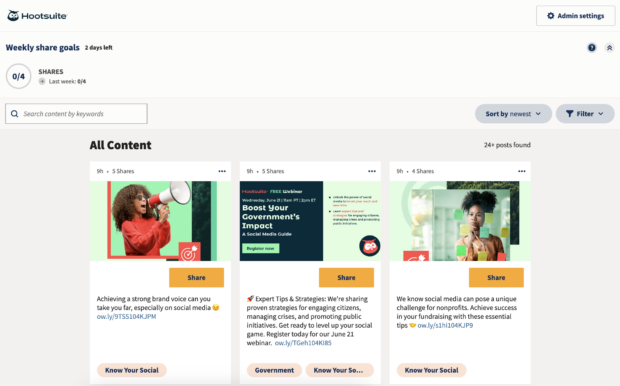
Affiliate marketing is flipside unconfined group of advocates that can help expand your reach and build your brand’s credibility. Requite them resources and training to help them spread the word on Facebook and proffer your targeted regulars through their own algorithm signals.
9. Interreact with influencers
Just as your employees can expand your reach, so too can influencers. Working with influencers who have a large and engaged pursuit signals to the Facebook algorithm that your content is authoritative and relevant.
Before collaborating with an influencer, do your research to make sure they uncurl with your trademark and have an engaged following. This will ensure that their posts well-nigh your trademark are genuine and resonate with their followers rather than coming wideness as inauthentic or forced (a bad signal to the algorithm).
10. Monitor analytics and insights
The weightier way to understand the Facebook algorithm is to track and measure your own performance. By monitoring analytics and insights, you can identify trends and patterns in engagement for your specific page.
You can then use this data to adjust and optimize your content strategy to largest uncurl with what resonates most with your audience.
Pro tip: Use Hootsuite Analytics to hands monitor Facebook post data and track your page’s performance over time. You can moreover compare your metrics to industry benchmarks to largest understand how you stack up versus competitors.
Facebook algorithm FAQs
What is Facebook’s algorithm?
The Facebook algorithm is a set of ranking signals powered by machine learning and strained intelligence. It calculates which content is most likely to request to each user and then delivers them a personalized feed.
How do you write-up the Facebook algorithm?
There is no way to “beat” the Facebook algorithm (and you will be penalized or plane have your worth disabled if you specifically try to trick the algorithm). However, there are plenty of strategies you can use to send powerful ranking signals to the algorithm.
The most important strategy is to create high-quality content that appeals to your specific regulars while staying engaged with followers and fans of your page.
How do I increase my Facebook algorithm?
To increase your Facebook algorithm, focus on creating high-quality and engaging content that resonates with your audience. Encourage interaction and conversation with your followers, and interreact with influencers and employees to expand your reach.
Additionally, regularly monitoring analytics and adjusting your content strategy therefrom can moreover help modernize your Facebook algorithm. Don’t try to game the system by using shortcuts or hacks, as these tactics will ultimately hurt your reach and engagement.
How do I reset my Facebook algorithm?
You can’t completely reset your Facebook algorithm, but there are a couple of steps you can take to make an firsthand transpiration to the content you see as a user, followed by an ongoing maintenance strategy to largest train the algorithm over time.
First up, the “reset.”
- Click your profile picture and select Settings and privacy > Feed.
- Use the options here to make an firsthand Facebook algorithm change.
- To see increasingly content from specific people and brands, add them to Favorites.
- To take a temporary break, Snooze them.
- Use the Unfollow option to stop seeing content from a person or trademark in your feed but remain unfluctuating with them.
- And scroll through the people and brands listed under Reconnect to see if there’s anyone you’ve unfollowed that you would like to see increasingly from again.
- Go when to Settings and Privacy, then click Settings, then click Ad Preferences in the left menu. Go to Ad Topics to review and transpiration the topics you want to see increasingly and less of in Facebook ads.
Next is maintenance. Use the in-feed options like Hide Post, Snooze, and Unfollow to tell the algorithm what you like and don’t. Be selective with the posts and pages you like going forward, as these all send signals to the algorithm that you want increasingly of that content.
Manage your Facebook presence slantingly your other social media channels using Hootsuite. From a single dashboard, you can schedule posts, share videos, engage your audience, and measure the impact of your efforts. Try it self-ruling today.

